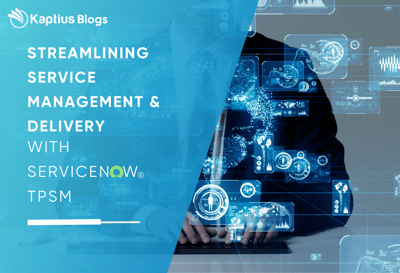Why Proactive Service is No Longer Optional?
The traditional, reactive approach to customer service is becoming obsolete. For Managed Service Providers (MSPs), waiting for customer-reported issues means falling behind competitors who offer proactive, predictive service capabilities. In industries like cloud, software, and infrastructure support, customers expect prevention, not just resolution.
By adopting a proactive service strategy powered by ServiceNow’s AI-powered AIOps, CMDB, and TPSM (Technology Provider Service Management), MSPs, especially those partnering with AWS, Microsoft Azure, and Google Cloud, can efficiently monitor infrastructure, endpoints, and software. The goal is not just maintaining uptime but improving security, performance, and customer satisfaction at scale.
The Shift to Proactive Service: Core Components
Proactive customer service requires several key enablers. These include real-time infrastructure monitoring, AI-driven event correlation, and deep visibility into customer assets and dependencies. Here’s how ServiceNow empowers this transformation:
1. ServiceNow’s AIOps for Incident Prediction and Automated ResolutionServiceNow’s AIOps capabilities play a critical role in shifting from reactive to proactive service by using machine learning models to predict and prevent incidents before they impact customers. By correlating events across cloud environments like AWS, Azure, and GCP, AIOps identifies root causes and recommends actions for automatic remediation.
- Automated Monitoring: Constantly monitor performance metrics and anomalies across diverse endpoints, cloud instances, and on-premise systems.
- Event Correlation: Consolidate and correlate alerts from multiple sources, reducing noise and focusing on actionable insights.
- Proactive Resolution: Trigger automated workflows to remediate issues, such as scaling cloud instances or restarting services, before customers experience downtime.
🔍 Example Use Case: An Azure-hosted application shows rising response times. AIOps detects this anomaly, correlates it with underlying server performance metrics, and automatically scales instances to maintain performance—without user intervention.
2. Comprehensive Visibility with CMDB and Customer Infrastructure Data
To deliver proactive service, MSPs must have real-time visibility into the health and configuration of customer assets. ServiceNow’s CMDB (Configuration Management Database) acts as the single source of truth for managing customer infrastructure data, including software, hardware, cloud services, and endpoints.
- Real-Time Asset Tracking: Keep track of every customer-managed endpoint, software deployment, and infrastructure component.
- Dependency Mapping: Understand how different assets, applications, and services are interconnected, enabling faster impact analysis during incidents.
- Lifecycle Management: Automate maintenance schedules, upgrades, and patches based on asset lifecycles, reducing unplanned outages.
Impact:
When a critical database hosted on Azure starts showing signs of stress, ServiceNow can automatically map it to the underlying VM, notify relevant teams, and trigger preemptive scaling to avoid disruptions.
3. TPSM (Technology Provider Service Management): Extending Proactive Services Beyond Infrastructure
For MSPs, proactive service goes beyond monitoring infrastructure. By leveraging TPSM in ServiceNow, MSPs can track the full lifecycle of software, subscriptions, and licenses, ensuring clients get the most value from their IT investments.
- Automated License and Subscription Monitoring: Ensure that customers’ licenses and cloud subscriptions don’t expire unexpectedly, disrupting operations.
- End-to-End Service Tracking: Monitor usage, entitlements, and support requests tied to specific products or services.
- Proactive Notifications: Automatically alert customers of potential license renewals or usage anomalies.
🔍 Example: A SaaS company providing critical collaboration tools notices that a customer’s license utilization is reaching its limit. TPSM triggers a proactive renewal notification and offers an upgrade recommendation, reducing downtime risks.
Use Case: Microsoft Partner as a Tech MSP Driving Digital Transformation with a Cloud-First Approach
A Microsoft Partner MSP supports a global retail customer undergoing a cloud-first digital transformation. The retailer plans to move all on-premise applications to Microsoft Azure while modernizing its customer experience platforms, including order management, e-commerce, and supply chain systems.
Challenges:
- The customer is concerned about service disruptions during the cloud migration.
- Maintaining real-time visibility across both on-prem and cloud environments is critical for smooth operations.
- The customer requires proactive security monitoring of endpoints to prevent data breaches during the transformation.

Solution:
The MSP leverages the MSP360 ServiceHub, CMDB, and ServiceNow’s AIOps to monitor and manage the entire transformation journey:
- Real-Time Visibility Across Environments: The CMDB maintains an updated record of all assets, including the on-premise legacy systems and newly migrated Azure components. Dependency maps help identify potential risks associated with each application being migrated.
- Proactive Issue Resolution Using AIOps:
AIOps continuously monitors application performance metrics during the migration. For example, when latency spikes in the database tier are detected, AIOps triggers automated scaling in Azure, preventing application downtime. - Endpoint Security with Managed SOC:
During the migration, the MSP’s Managed SOC service monitors endpoints for suspicious activity, such as unauthorized access attempts. Any anomaly triggers real-time alerts and isolation of affected devices, ensuring security is maintained. - Lifecycle Management and Proactive License Renewals:
Using TPSM, the MSP ensures that the customer’s cloud subscriptions are properly managed, with automated reminders for renewals and proactive suggestions for capacity upgrades based on usage.
Results:
- The migration is completed with zero unplanned downtime, thanks to proactive monitoring and automated resolutions.
- Security incidents are detected and resolved without affecting business operations, safeguarding sensitive customer data.
- The customer achieves improved performance and scalability, resulting in enhanced user experiences and operational efficiency.
Managed SOC: Proactively Managing Security and Endpoints
One of the most critical areas for proactive service is security management. With cyber threats on the rise, MSPs offering security services need continuous endpoint monitoring, threat detection, and real-time incident response. ServiceNow’s Managed SOC capabilities, integrated with the MSP360 ServiceHub, help MSPs manage security risks for their clients effectively.
How Managed SOC Enables Proactive Security
- Continuous Monitoring of Endpoints and Threat Surfaces:
Monitor endpoints, devices, and networks for unusual activity or vulnerabilities using integrated security tools. - Threat Intelligence and Automated Response:
Use threat intelligence feeds and AI to detect suspicious activity early and trigger automated responses, such as isolating compromised endpoints or patching vulnerabilities. - Proactive Security Posture Management:
Regularly assess and improve the security posture of customer environments by analysing endpoint configurations, patch levels, and security gaps.
Measurable Outcomes of Proactive Service
- Reduced Downtime:
By predicting and resolving issues before they escalate, MSPs can dramatically reduce unplanned downtime and SLA violations. - Enhanced Security Posture:
Continuous monitoring of endpoints and proactive patching reduce vulnerability windows and minimize cyber risks. - Higher Customer Satisfaction:
Proactive service delivery leads to higher CSAT and NPS scores as customers experience fewer disruptions and greater peace of mind. - Operational Efficiency Gains:
By automating incident detection, response, and asset management, MSPs can optimise resource allocation and reduce operational costs.
The Proactive Future of MSPs
In today’s competitive landscape, reactive service is no longer enough. Customers expect proactive and predictive service models that maximise uptime and minimise risks. By adopting ServiceNow’s Service Ops, CMDB, and TPSM capabilities within the MSP360 ServiceHub, MSPs can deliver:
- Seamless multi-cloud infrastructure monitoring
- AI-powered automated issue resolution
- Proactive security management through Managed SOC
- Enhanced customer satisfaction through lifecycle management and proactive communication
Are you ready to take the next step in proactive service transformation? Let’s connect to explore how the MSP360 ServiceHub can drive success for your MSP.
-1-1.png?width=1500&height=583&name=Poorna_2_Logo_Vector_Kaptius_Final_file-03%20(1)-1-1.png)




